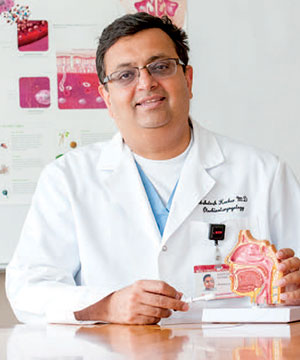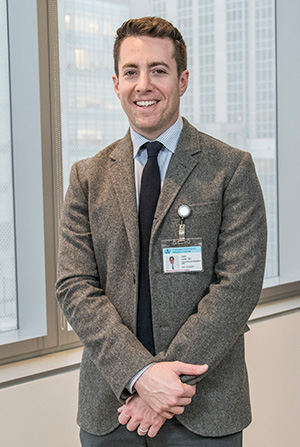Advanced Otolaryngology — Head & Neck Surgery
Minimally Invasive Head & Neck Surgery
NewYork-Presbyterian's head and neck surgeons are leaders in the use of minimally invasive approaches — including transoral robotic surgery, salivary endoscopy, and transnasal skull base surgery — to remove tumors and obstructions of the salivary glands, mouth, throat, thyroid and parathyroid glands, larynx, and cervical spine. Our teams were among the first adopters of robotic techniques and continue to expand its applications across the field of otolaryngology.
-
Pioneering sialendoscopy. NewYork-Presbyterian/Weill Cornell is one of the few institutions offering salivary endoscopy, a highly technical procedure, to remove stones in the salivary glands – sparing patients from invasive open procedures on the parotid or submandibular glands which raise the risk of nerve damage. They also use sialendoscopy to address salivary gland inflammation, such as that seen in patients with Sjögren's syndrome — opening the obstructed duct with a balloon and stent and applying steroid treatment.

Ashutosh Kacker, MD, otolaryngologist and skull base surgeon, NewYork-Presbyterian/Weill Cornell
-
Expanding ear endoscopy. NewYork-Presbyterian/Columbia has a growing ear endoscopy program — the first in the New York metropolitan area — offering less invasive transcanal access to middle ear surgeries for otologic diseases (such as tympanic membrane perforations, conductive hearing loss, and small cholesteatomas) that would otherwise require a larger incision to remove tissue blocking the surgical site. In concert with carefully executed surgical maneuvers, the endoscope offers a number of advantages for select ear surgeries.

David A. Gudis, MD, Chief, Division of Rhinology and Anterior Skull Base Surgery,
NewYork-Presbyterian/Columbia -
Leaders in skull base surgery. NewYork-Presbyterian surgeons are among the world's leaders in the use of transnasal and transoral endoscopic approaches in children and adults, leaving the patient with no visible incisions. Our surgeons are experienced in the full range of endoscopic skull base procedures, including the treatment of sinus and nasal cancers, pituitary tumors, neuropapillomas, Schwannomas, dermoid cysts, angiofibromas, cervical vertebral dislocation causing compression of the spinal cord, and Chiari malformation. ENT surgeons and neurosurgeons work side-by-side to access these delicate areas.
-
Advanced parathyroid surgery. NewYork-Presbyterian/Weill Cornell is a leader in the use of imaging to guide parathyroid surgery. They employ high-sensitivity four-dimensional computed tomography/ultrasound to localize abnormal parathyroid glands, without the need for full surgical opening of the neck. The program is one of the first of its kind in the country, offering an approach which can spare patients from unwarranted surgery.
-
Specialized reconstruction. For patients who require open surgery, our reconstructive surgeons collaborate with facial and plastic surgeons, performing flap procedures to preserve function and cosmesis.
Selected Publications
-
Idiopathic chronic parotitis: imaging findings and sialendoscopic response. ORL; Journal of Oto-Rhino-Laryngology and its Related Specialties. 2015;77(5):302-9.
-
Sialoendoscopy in the diagnosis and management of obstructive sialadenitis. The Laryngoscope. 2011;121(3):495-500.
-
Building an endoscopic ear surgery program. Current Opinion in Otolaryngology and Head and Neck Surgery. 2016;24(5):395-401.
-
Quality of life after combined endonasal endoscopic odontoidectomy and posterior suboccipital decompression and fusion. World Neurosurgery. 2018;116:e571-e576.
-
Endoscopic pituitary surgery: A systematic review and meta-analysis. Journal of Neurosurgery. 2009;111(3):545-54.
-
Predictors of short-term outcomes following endoscopic pituitary surgery. Clinical Neurology and Neurosurgery. 2009;111(2):119-22.
-
Endoscopic cranial base surgery: classification of operative approaches. Neurosurgery. 2008;62(5):991-1002.
-
Localization of small parathyroid adenomas using modified 4-dimensional computed tomography/ultrasound. Otolaryngology Head and Neck Surgery. 2012;146(1):33-9.
-
Parathyroid localization and preservation during transcervical resection of substernal thyroid glands. Otolaryngology Head and Neck Surgery. 2015;152(6):1024-8.
Facial Plastic Surgery
Our teams include otolaryngologists with additional fellowship training in facial plastic and reconstructive surgery. They provide treatment for conditions and deformities related to trauma and cancer and a wide range of elective cosmetic procedures, including:
-
Repair of head and neck trauma and complicated facial fractures
-
Plastic and reconstructive surgery for patients who have had large excisions
-
Cosmetic procedures of the face and neck, to restore form and function
-
Complex craniofacial reconstruction in children and adults
Our head and neck reconstructive plastic surgeons are conducting research related to nerve and cartilage regeneration, which would allow for more comprehensive facial restoration following disfiguring congenital, oncologic, or traumatic defects. They’re also using 3D printing to design components for facial reconstruction.



